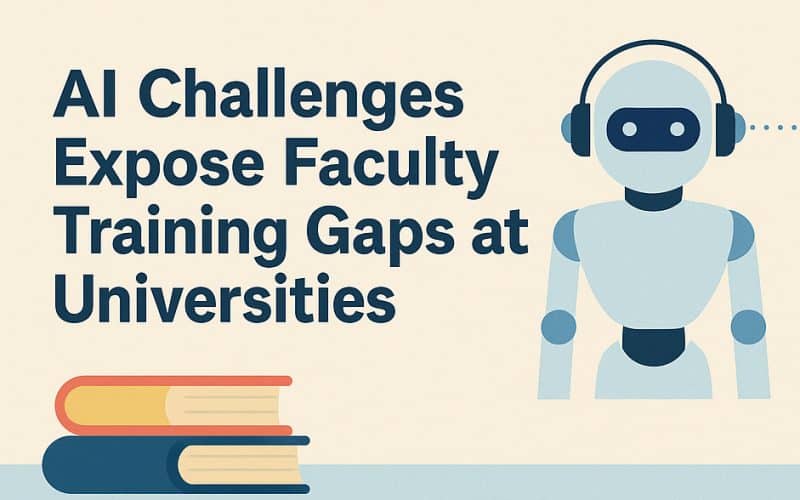
In 2023, Harvard University introduced an AI-powered teaching assistant in its flagship computer science course, CS50. Built on OpenAI’s ChatGPT, the assistant was tasked with answering questions, debugging student code, and offering personalized feedback. While the rollout demonstrated the transformative potential of artificial intelligence in higher education, it also laid bare a deeper systemic issue: many university instructors lack the knowledge, support, and confidence to integrate AI into their teaching practices effectively. In short, also universities battle with the AI challenges of today.
In this article we go deeper into the (lack of) readiness of university educators to guide students through this technological shift.
Faculty Unprepared for AI Challenges and Integration
Numerous studies have confirmed a widespread gap in AI literacy among university educators. While stakeholders across sectors acknowledged the promise of AI in education, teaching professionals expressed significantly more hesitation and skepticism than engineers or business leaders. Teachers and academic staff were particularly concerned about:
- A lack of foundational understanding of how AI systems work;
- Ethical concerns over data privacy and bias;
- A perceived threat to traditional pedagogical roles and job security.
A recent global survey by the Digital Education Council (DEC) sheds further light on the current state of AI literacy among university faculty worldwide and the AI challenges they face. The 2025 Global AI Faculty Survey, encompassing responses from 1,681 faculty members across 52 institutions in 28 countries, reveals large gaps in AI training and institutional support.
Key Findings:
- AI Proficiency Levels: Only 17% of faculty members consider themselves at an advanced or expert level in AI proficiency. Conversely, 40% identify as beginners or having no understanding of AI.
- Institutional Support: A mere 6% of faculty strongly agree that their institutions have provided sufficient resources to develop their AI literacy. Additionally, only 4% are fully aware of their institution’s AI guidelines and find them comprehensive.
- AI Usage in Teaching: While 61% of faculty have used AI in their teaching practices, 88% of these users report only minimal to moderate usage, indicating a cautious approach to AI integration.
- Perception of AI’s Role: Despite limited training, 86% of faculty foresee themselves using AI in future teaching, with 65% viewing AI as an opportunity and 35% perceiving it as a challenge.
These findings show indeed a critical need for enhanced AI training and clearer institutional guidelines to empower faculty in effectively integrating AI into higher education.
Below are all of the – sometimes rather shocking – results.
| Metric | Value |
|---|---|
| Faculty identifying as advanced or expert in AI proficiency | 17% |
| Faculty identifying as beginners or having no understanding of AI | 40% |
| Faculty who have used AI in teaching | 61% |
| Among AI users, those reporting minimal to moderate usage | 88% |
| Faculty foreseeing themselves using AI in future teaching | 86% |
| Faculty viewing AI as an opportunity | 65% |
| Faculty viewing AI as a challenge | 35% |
| Faculty concerned about students’ ability to critically evaluate AI output | 83% |
| Faculty worried about students becoming too reliant on AI | 82% |
| Faculty believing current student evaluation methods are inadequate | 54% |
| Faculty calling for an urgent, complete revamp of student evaluations | 13% |
| Faculty fully aware of their institution’s AI guidelines | 4% |
| Faculty who strongly agree their institution has provided sufficient AI training resources | 6% |
Barriers to Faculty AI Readiness
1. Institutional Inertia and Lack of Support Structures
Most higher education institutions still lack structured programs to support faculty development in AI. Training, if available, is often voluntary, ad hoc, and not linked to promotion or evaluation criteria. In Turkey, for example, academic staff surveyed in the “The Future of Education Utilizing Artificial Intelligence in Turkey” study by Mustafa İçen reported institutional ambiguity around AI’s role in classrooms, leaving faculty to interpret and implement AI integration independently.
2. Fear of Job Displacement and Devaluation of the Educator Role
Faculty responses indicate an existential anxiety about the role of AI in the classroom. Teachers expressed concern that AI might replace not just administrative tasks but core teaching responsibilities. One participant in the above mentioned study warned, “I believe the teacher’s place will shrink,” while another cautioned that “robotic teaching” could erode the human elements of mentorship and critical dialogue.
These fears may be exacerbated by public narratives, such as the 2025 launch of Mechanize, a startup aiming to replace all knowledge work with AI agents. Such developments amplify concerns that AI tools could bypass rather than support educators.
3. Lack of Technical and Pedagogical Training
Many instructors lack both the technical background to understand AI systems and the pedagogical frameworks to apply them meaningfully. This results in either avoidance or superficial use – such as using AI to automate grading – without considering how it can deepen conceptual learning or support equity. Effective AI literacy must include not just tool use, but understanding of algorithmic bias, ethical design, and data governance.
Concrete Examples of Faculty AI Knowledge Gaps
Several cases illustrate how this knowledge gap manifests in practice:
- Georgia Tech’s “Jill Watson”: In 2016, Georgia Tech deployed an AI teaching assistant named “Jill Watson” in an online course. Students interacted with the bot for months without realizing it wasn’t human. While praised as a success, the rollout revealed a lack of faculty-wide awareness about how to communicate or ethically deploy such tools transparently.
- Faculty Misconceptions and Sci-Fi References: In interviews for the “The Future of Education Utilizing Artificial Intelligence in Turkey” study by Mustafa İçen, some educators referenced science fiction, including Asimov’s robot laws, when discussing AI policy in education – demonstrating a conceptual conflation between fictional narratives and real-world capabilities.
- Over-reliance Without Critical Understanding: A 2024 study from Microsoft and Carnegie Mellon found that frequent AI users in professional settings completed tasks faster but with diminished critical engagement. This raises concerns that untrained faculty may similarly over-rely on generative AI outputs without verifying accuracy or fairness.
Institutional Efforts to Bridge the Gap and Tackle AI Challenges
Some universities have started building capacity through targeted programs:
- University of Florida launched “AI Across the Curriculum” in 2021, offering workshops, micro-credentials, and cross-disciplinary AI integration tools for faculty.
- Auburn University developed a self-paced online course, Teaching with AI, which introduces educators to generative AI, instructional design adaptations, and ethical frameworks.
- ETH Zurich set up an interdisciplinary AI Education Incubator in 2023, combining insights from learning sciences and computer engineering to co-design AI-enhanced learning environments.
- IIT Madras integrated AI teaching assistants in labs while requiring faculty to earn AI pedagogy certifications, ensuring technical and ethical competence.
Despite these efforts, implementation remains extremely patchy and often siloed within technical departments. Humanities and social sciences, where critical engagement with AI’s societal impacts is vital, frequently lack such infrastructure.
The Path Forward
To ensure educators are equipped to guide students through the AI-driven transformation of work and society, universities must adopt a more coordinated, cross-functional approach to faculty development. Key recommendations include:
- Mandatory AI Literacy Training for all instructors, including ethical use, bias awareness, and technical fluency.
- Integration into Promotion Criteria, incentivizing faculty to develop AI-enhanced pedagogy.
- Interdisciplinary Collaboration through teaching innovation hubs that bridge technical and humanistic expertise.
- Transparent Policy Frameworks around data privacy, academic integrity, and student rights in AI-supported environments.
AI Understanding is the Foundation of Higher Education
AI is poised to play an increasingly central role in education – not just as a tool, but as a catalyst for redefining how learning is structured, delivered, and assessed. Yet this transformation will only be successful if faculty are empowered to lead it.
Without deliberate investment in faculty training, universities risk entrenching inequalities between departments, delaying innovation, and misapplying powerful technologies. Equipping educators with the knowledge to critically and creatively engage with AI is foundational to the future of higher education.
